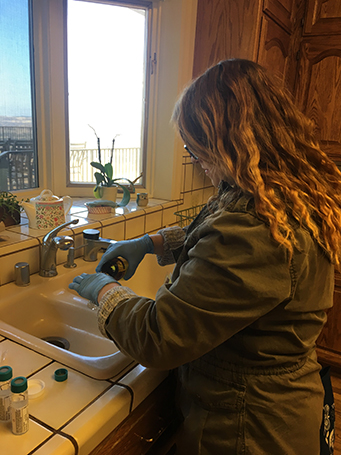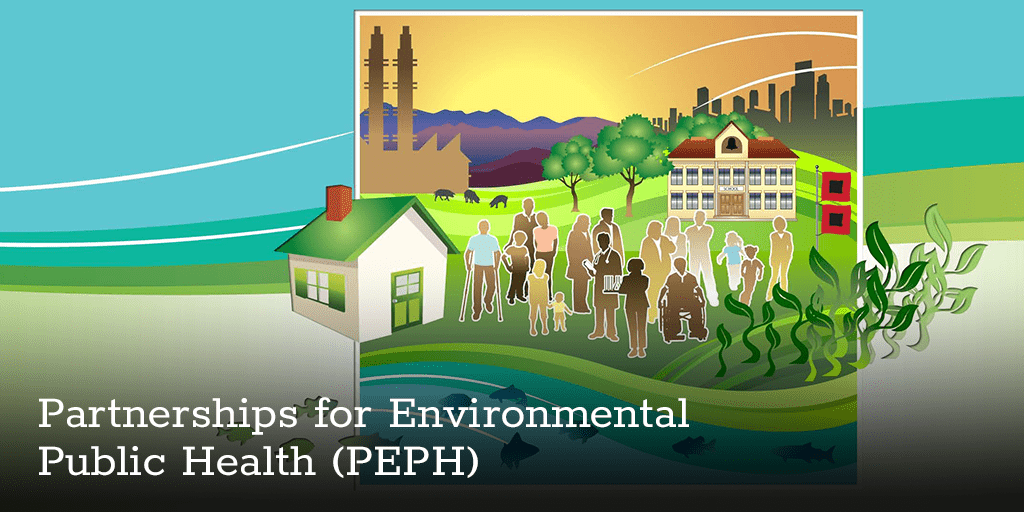Kathreen “Nica” Daria of the Public Health Institute samples water from a Paradise household. (Photo courtesy of Gina Solomon)
Communicating environmental health information quickly after a disaster is critical and allows residents to take protective actions against harmful environmental exposures. When residents began to return to the town of Paradise, California, after evacuations caused by the devastating 2018 Camp Fire, they were unsure whether it was safe to use the tap water. Community-wide sampling from local water utilities had found contamination in the public water supply, but NIEHS-funded researchers at the University of California, San Francisco and the Public Health Institute were interested in sampling that would provide households with their own water results. A recent paper describes how the researchers developed and implemented this strategy by partnering with local organizations and community leaders.
“Our team’s NIEHS Disaster Research Response funding enabled us to work with the Paradise community soon after residents began to return,” reflected Gina Solomon, M.D., M.P.H., principal investigator of this project. “In a highly accelerated timeframe, we were able to recruit participants, sample household water supplies, and develop an effective communications framework that empowered residents to make decisions relevant to their own health.”
Testing for Water Contamination After a Wildfire
The research team aimed to provide residents of each home with water quality results and actionable information about ways to reduce exposure to harmful contaminants. Researchers recruited residents through a variety of channels, such as a community meeting, flyers, social media, email, and door-to-door visits. Local and state organizations also supported recruitment. For example, the California Office of Emergency Services and the local water utility hosted a community meeting attended by over 100 residents. The community meeting also served as a way for researchers to directly hear residents’ concerns and use their feedback to tailor communications materials. Residents of 136 homes, or roughly 10% of all homes that remained after the fire, participated in the study.
The researchers returned results to participants within two weeks of receiving the results from the laboratory. The rapid timeline was important to meet the community’s need to have actionable information in a timely manner.
“We had previously worked with Tracking California on community environmental health concerns. We further developed partnerships with the California Water Resources Control Board’s Division of Drinking Water, The North Valley Community Foundation, Paradise Irrigation District, and the University of California Davis Environmental Health Center. All these organizations helped to recruit residents for the study and helped develop and test communications materials,” stated Solomon. “In the aftermath of a disaster, it is critical to respond to the community’s needs and earn their trust to return reliable and useful results.”
Developing a Framework to Return Results to Residents

Kelsa Lowe, a graduate student at the University of California Davis, takes water samples at a home in Paradise. (Photo courtesy of Gina Solomon)
This intervention reflects a new development in crisis and disaster communication in that results needed to be individualized rather than community-wide. Therefore, researchers developed a framework that incorporated aspects of individual results and crisis communication while also considering the disaster context by communicating with first responders and avoiding interference with recovery efforts. Researchers also prioritized trauma-informed communications and personally connected with residents through household visits which included sampling and personalized communications. Overall, the framework met the community’s needs to have accessible information in a timely manner.
The research team sent result reports together with additional information, including fact sheets for each chemical detected in the household’s water sample; responses to FAQs raised during the community meeting; and an explanation of how the researchers’ testing methods compared to those of the local utilities in order to reduce confusion from discrepancies in the data.
“As is often the case in disaster communication, we were unable to fully pilot test materials given the short timeline. However, we used best practices and lessons learned from the community to develop reliable information that met their needs,” reflected Julie Von Behren, M.P.H., collaborating researcher on this project. “Working quickly like this, we also learned we had to be adaptive. For example, we made fact sheets on common contaminants in parallel with the sampling but had to make new ones for unanticipated contaminants. But the effort that went into providing so many details went a long way to helping the community take informed actions on their water use.”
When water sampling results came in, researchers categorized each household based on the severity of contamination. Households with water contamination above or near regulatory limits were prioritized and received information immediately, along with an offer of follow-up testing. While information packets were sent to all participants, residents could also attend a community meeting about the results and could choose to discuss results with the researchers either by phone or in-person.
Determining Success of Returning Results to Residents
Researchers surveyed participants about their water usage, concerns about contaminants, and how they felt about the research and communications process. Before receiving results, 47% of Paradise residents and 33% of nearby residents reported they were very worried about the safety of their water. After receiving results and communications materials, 56% of respondents were much less worried about the water, and 21% were slightly less worried, because they found out their own water supply was safe. About one-quarter of participants reported taking an action related to water usage after the study, such as installing a water filter. Over 83% of respondents stated the materials were understandable and 87% found them useful.
“The range of activities taken after receiving the results is consistent with the fact that each household had different contaminant levels,” stated Von Behren. “The benefit of this study and our individualized approach is that we were able to communicate information depending on a household’s circumstances.”
The researchers uploaded their questionnaires and other materials related to returning results to the NIEHS Disaster Research Response (DR2) Resources Portal so that other researchers studying the aftermath of wildfires or drinking water contamination have materials they can rapidly repurpose.
“Disaster results communication research is a developing field,” stated Solomon. “Principles of trauma-informed community engagement need to be incorporated into tailored communications, all under extreme time pressure. The resources we created can help others incorporate these principles effectively.”
Source link
www.niehs.nih.gov


